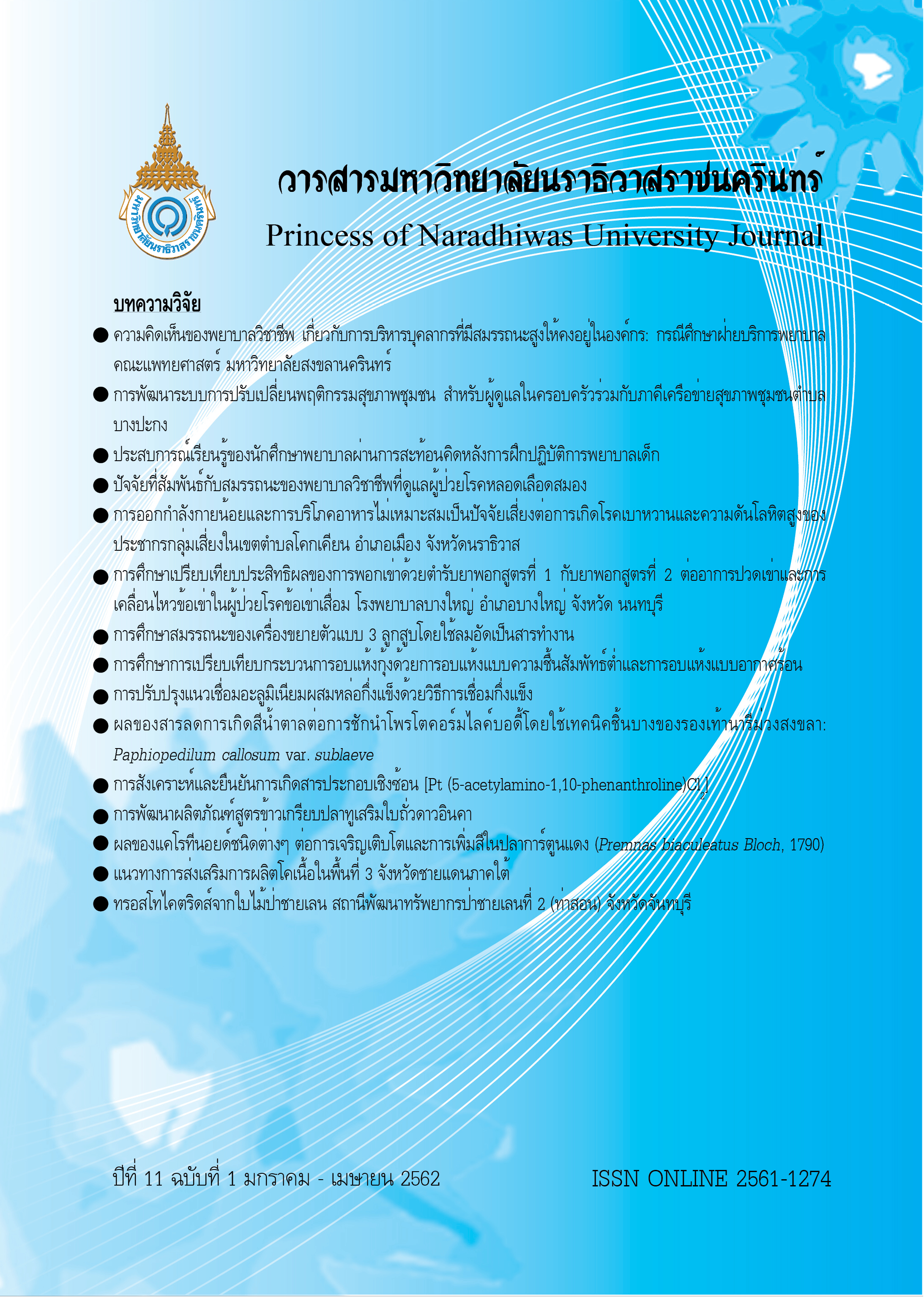The Development on Formulation of Fish Cracker Supplemented with Sacha Peanut Leaf
Keywords:
Sacha Inchi fish cracker, Chemical properties, Sensory evaluationAbstract
Presently, fish crackers which are sold in the market have the low level of antioxidant and fiber
because the main ingredients of the fish crackers are powder and protein. Therefore, the objective of this
study was to develop a mackerel fish crackers product supplemented with Sacha peanut leaf effected with
chemical properties and sensory quality. The study also aimed to analyse the mackerel fish crackers nutrition
compared with original fish ones. The results of this study found that the development of a mackerel fish crackers
product supplemented with Sacha peanut leaf, which was based on the 6th formula showed the highest
score of the sensory quality, 8.47. The moisture value was 7.23% which dry weigh and aw were 0.60 which
conformed to the standard value. Additionally, with regards to the developed fish crackers, the study revealed that the developed fish crackers contain 912.35 mg/kg of Calcium and (EC50) 857.80 ug/mg of the antioxidant. Therefore, based on these findings, it can be noted that the mackerel fish crackers product may upgrade the quality of local fish crackers product by means of adding nutritional values to the product and may respond to the needs of customers who love stay healthy. Most importantly, this product can one of the Halal product.
References
A.O.A.C. (1998). Official methods of analysis of the association of official analytical chemists. (15th ed). Virginia: Association of Official Analytical Chemists, Inc.
A.O.A.C. (2000). Official methods of analysis of the association of official analytical chemists. 15th ed). Virginia: Association of Official Analytical Chemists, Inc.
Charunuch, C., Pengpinij, W., Limsangouan, N., Puntaburt, K. & Prasert, W. (2015). Innovation extrusion. Bangkok: Kasetsart University. (in Thai)
Chedoloh, R. (2017)(a). Development of Defatted Rice Bran Fish Crackers to Improve Nutrition and Antioxidant.
Agricultural Research Development Agency (Public Organization).
Chedoloh, R. (2017)(b). Effects of packaging and shelf-life on quality and antioxidant property of defatted rice bran supplemented in raw fish crackers. The Journal of Applied Science, 16(2), 47-64.
Kheeree, N. (2015). Study on the Chemical Properties of Fried Fish Chip with Mixed Herbs, Galangal, Lemon
Grass, Kaffir Lime Leaves and Chili. Princess of Naradhiwas University Journal, 7(2), 129-136.
Kraljic, K., Skevin, D., Barisic, L., Kovacevic, M., Obranovic, M. & Jurcevic, I.(2015). Change in 4-vinylsyringd and other phenolics during rapeseed oil refining. Food Chemistry, 187, 236-242.
Ministry of Public Health. (2003). Nutritive value of thai food. (3th ed.) Bangkok: Express Transportation Organization of Thailand. (in Thai).
Nurul, H., Ang, Li.L. Chung. X.Y. & Herpandi. (2010). Chemical composition, color and linear expansion properties of Malaysian commercial fish cracker (keropok). Journal of Food and Agro-Industry, 3(5), 473-482.
Puwaphut, R. (2016). The Comparison in Patentability of Young Leaf, Immature Leaf and Mature leaf of Sacha incha in Secondary Metabolite Production Response for Local Tea Product of Narathiwat. Princess of Naradhiwas University Journal, 8(2), 125-133.
Rattanapanone, N. (2002). Food Chemistry. Bankok. (in Thai)
Rangsardthong, V.(2002). Food processing technology. Bankok : Agro-Industrial Technology Environmental Technology. (in Thai)
Saah, N., Chedoloh, R. & Adair, A. (2015). Production and Properties of Fish Crackers Substituted with Soybean Meal. Journal of Community Development and Life Quality, 3(3), 351-359.
Shimada, K., Fujikawa, K. Yahara, K. & Nakamura, T. (1992). Antioxidative properties of xanthans on the autoxidation of soybean oil in Cyclodextrin Emulsion. Journal of Agricultural and Food Chemistry, 40(6), 945-948.
Sihamala, O. (2002). Improvement of Nutritional Quality and Shelf-life of Fish Crispy. Ching Ma: Food Science
and Technology, Ching Mai Uneversity. (in Thai).
Sihamala, O., Bhulaidok, S. & Songsiri, P. (2003)(b). The study for an optimum formula of mulberry leaf crispy.
Kalasin: Faculty of food technology, Rajamangala University of Technology Isan Kalasin. (in Thai).
Siwawej, S. & Supphongsiri, S. (1993). Sorghum Chips. Agricultural Science Journal, 26(4-6), 80-87.
Suriya, P., Thamaragsa, N., Kaewtein, S., Pocarat, R. & Arkanit, K. (2011). Product development of Burma bean chip. The 2nd MJU-Phrae National Research Conference. September 1-2, 2011, Chiang Mai: Maejo University. (in Thai)
Tangkhanakun, P. (2003). Varieties of crackers. Food Journal (Thailand), 33(3), 162-167.
Thai Industrial Standards Institute. (2011). Thai Community Products Standards 107/2554: Crispy Snack, Khaogriab. Bangkok: TISI, Ministry of Industry. (in Thai)
Wang, X.Y., Yang, D., Zhang, H., Jia, C.H., Shin, J.A., Hong, S.T., Lee, Y.H., Jang, Y.S. and Lee, K.T. (2014). Antioxidant activity of soybean oil containing 4-vinylsyringol obtained from decarboxylated sinapic acid. Journal of the American Oil Chemist’Society, 91, 1543-1550.



